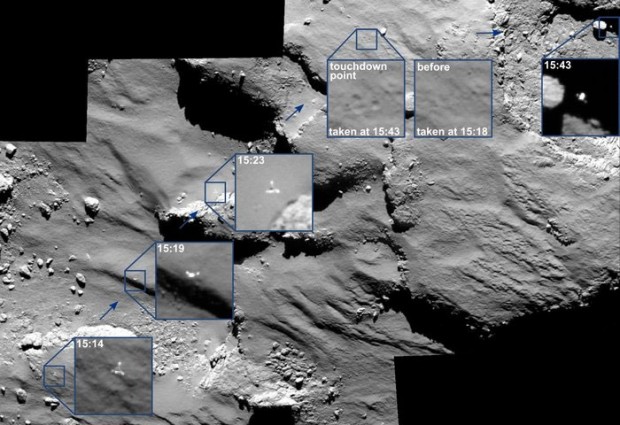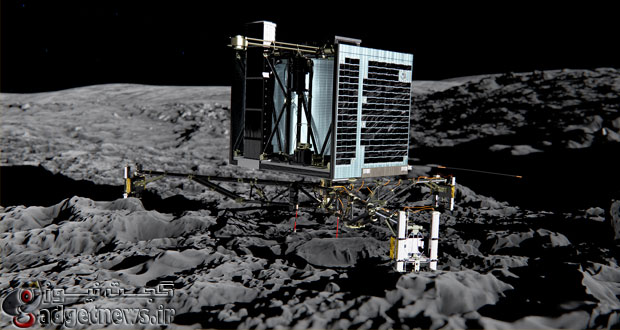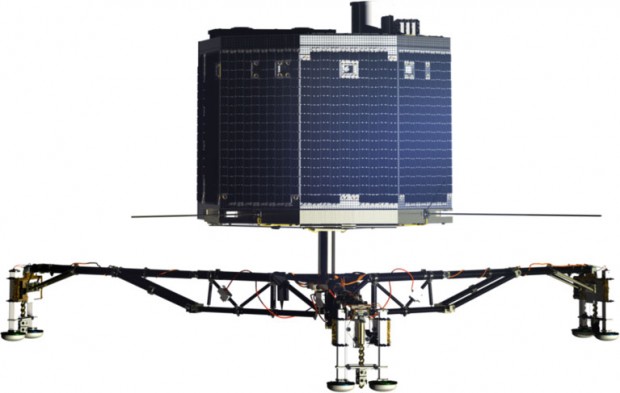محققان آژانس فضایی اروپا (ESA) امیدوارند که با نزدیک شدن دنبالهدار 67P به خورشید، امکان بیدار کردن و برقراری ارتباط مجدد با فرودگر Philae فراهم شود.
فرودگر Philae بعنوان بخشی از برنامه فضاپیمای روزتا 12 نوامبر (21 آبان) در یک مأموریت تاریخی بر سطح دنبالهدار 67P/Churyumov-Gerasimenko فرود آمد.
این فرودگر در مدت فعالیت، اطلاعات ارزشمندی شامل وجود یخ آب و مولکولهای آلی بر سطح دنبالهدار به زمین مخابره کرد؛ اما مدت مأموریت بدلیل اتمام باتری بسیار کوتاه بود.
در تصاویر مخابره شده توسط فضاپیمای مادر (روزتا)، فرودگر Philae در سایه یک صخره قرار گرفته است که دریافت نور خورشید و شارژ باتری را غیرممکن میکند.

جزئیات فرود و برخوردهای فیله با سطح دنباله دار را با ذکر ساعت در تصویر بالا مشاهده می کنید. ( برای مشاهده تصویر در ابعاد اصلی بر روی آن کلیک کنید )
محققان آژانس فضایی اروپا (ESA) پیش از اتمام باتری، در یک اقدام موثر اقدام به چرخاندن پنل خورشیدی بزرگ فرودگر بسمت خورشید کردند.
«استفان اولامک» مدیر پروژه فرودگر Philae عنوان کرد: امید زیادی به شارژ باتری و برقراری ارتباط مجدد با فرودگر داریم.
امکان برقراری ارتباط مجدد با فرودگر در بهار 2015 (بهار 94) پیشبینی شده است، زمانیکه دنبالهدار و فرودگر بر روی آن به خورشید نزدیکتر شوند؛ چند روز قرار گرفتن در معرض نور خورشید برای شارژ کامل باتری با استفاده از پنل خورشیدی کفایت میکند.
در صورت شارژ شدن مجدد باتری Philae، این فرودگر میتواند دور جدیدی از تحقیقات علمی خود را بر سطح دنبالهدار 67P آغاز کند.
منبع : teachingkidsnews
Scientists Hope Philae Will Wake Up Next Spring
Scientists Hope Philae Will Wake Up Next Spring
The Philae spacecraft that landed on a comet last week has gone to sleep. But the good news is that scientists are hopeful that we haven’t heard the last messages from the spacecraft.
Scientists hope it will “wake up” next spring and send more information back to Earth.
Scientists had sent the washing machine-sized spacecraft on a 10-year journey to a comet known as 67P (short for 67P/Churymov-Gerasimenko).
On November 12 it reached its destination and scientists at the European Space Agency (ESA) successfully landed it on the icy surface of the speeding comet.
Philae immediately started sending back information about the comet to Earth which scientists will study and learn from. The information Philae sent included photos and even sounds.
Unfortunately, during the difficult landing Philae bounced. Twice.
It was supposed to fire “harpoons” into the comet. The harpoons would stick it to the surface of the comet. However, the harpoons never fired.
Philae’s first bounce wasn’t like a bounce on Earth. Because of the lack of gravity, this one lasted two hours—and was about one kilometre high–before Philae finally came down again. The second bounce lasted about seven minutes.
After that, Philae sat a bit lopsided on the comet, on just three jets and leaning on a rock.
Because Philae landed about a kilometre away from its intended landing site, it was more in the shade than scientists hoped. That meant there wasn’t enough sunlight to power the spacecraft’s solar panels (a type of battery that makes electricity for the spacecraft, to power it).
The scientists quickly sent instructions to Philae to send back some data about the comet. They also had it drill into the surface of the comet to collect material which scientists want to study.
But then its solar panels ran out of energy and Philae fell silent.
The good news is that next year, around August 2015, the comet will move much closer to the sun. Scientists hope the sun’s rays will power the solar panels and Philae will work again.
The information Philae is sending back to Earth is very important. In fact, scientists hope it will shed some light on the origins of our universe.
We will have to wait and see—and hope Philae gets some sun.
CURRICULUM CONNECTIONS
By Jonathan Tilly
Writing/Discussion Prompt
The news of the Philae shutting down must have been very dissapointing for the men and women who worked so hard on this project. Nonetheless, by hoping that Philae will restart in 2015, they are being optimistic. Retell a situation where you stayed optimistic despite an unfortunate circumstance or situation.
Reading Prompt: Comprehension Strategies
Today’s article explains that,
Philae’s first bounce wasn’t like a bounce on Earth. Because of the lack of gravity, this one lasted two hours—and was about one kilometre high–before Philae finally came down again. The second bounce lasted about seven minutes.
What do you think that would look like? How would it feel to bounce for that long and far?
How does imagining a scene in our mind help with comprehension (understanding)?
Junior
Identify a variety of reading comprehension strategies and use them appropriately before, during, and after reading to understand texts (OME, Reading: 1.3).
Intermediate
Identify a variety of reading comprehension strategies and use them appropriately before, during, and after reading to understand increasingly complex texts (OME, Reading: 1.3).
Language Feature: Personification
In this article, doesn’t Philae seem “alive”? Of course, it’s not. Philae is a machine, made by humans. But terms like “wake up” or “fell silent” to describe an inanimate (not alive) object help the reader to understand Philae. They also make the writing more interesting.
 گجت نیوز آخرین اخبار تکنولوژی، علم و خودرو
گجت نیوز آخرین اخبار تکنولوژی، علم و خودرو 







